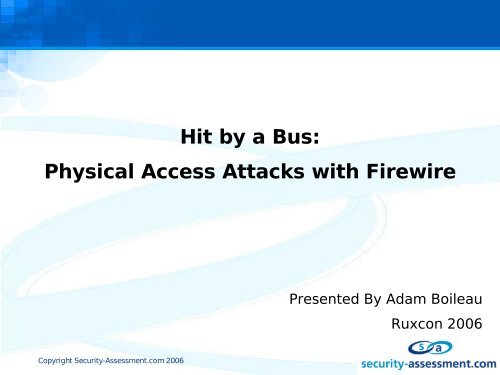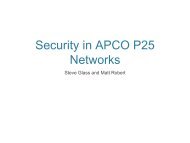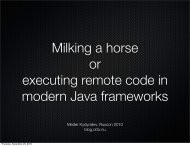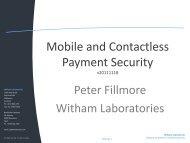Hit by a Bus: Physical Access Attacks with Firewire - 2008 - Ruxcon
Hit by a Bus: Physical Access Attacks with Firewire - 2008 - Ruxcon
Hit by a Bus: Physical Access Attacks with Firewire - 2008 - Ruxcon
Create successful ePaper yourself
Turn your PDF publications into a flip-book with our unique Google optimized e-Paper software.
<strong>Hit</strong> <strong>by</strong> a <strong>Bus</strong>:<br />
<strong>Physical</strong> <strong>Access</strong> <strong>Attacks</strong> <strong>with</strong> <strong>Firewire</strong><br />
Presented By Adam Boileau<br />
<strong>Ruxcon</strong> 2006<br />
Copyright Security-Assessment.com 2006
About Me<br />
• Adam Boileau, Senior Security Consultant,<br />
Security-Assessment.com<br />
• There's a few of us here this year...<br />
• I'm a Unixy, networky sorta guy, I like python, I<br />
play <strong>with</strong> wireless.<br />
• You might remember me from Rux last year...<br />
• ... or maybe you've seen my robotic lego yagi<br />
scoping out your wireless networks :)<br />
Copyright Security-Assessment.com 2006
Copyright Security-Assessment.com 2006
Copyright Security-Assessment.com 2006
Introduction<br />
• Intro (
<strong>Physical</strong> <strong>Access</strong> <strong>Attacks</strong><br />
• Assertion: <strong>Physical</strong> access to a general purpose<br />
computer is game over<br />
• Qualifiers: “general purpose”<br />
Systems that are not designed to operate in a hostile<br />
environment. Commodity kit.<br />
Compare <strong>with</strong> ATMs, custom kiosks, parking meters<br />
• Traditional physical access attacks include:<br />
Booting off disk/CD/USB to gain raw disk access<br />
Bypass BIOS password <strong>with</strong> the CMOS reset jumper<br />
Hardware keyboard loggers<br />
• Hardened systems also get attacked:<br />
Side channel attacks on crypto smartcards (<strong>Ruxcon</strong> 03!)<br />
ATM data circuit MitM<br />
Copyright Security-Assessment.com 2006
<strong>Physical</strong> <strong>Access</strong> <strong>Attacks</strong><br />
• ATMs: hardened hardware<br />
for hostile environments!<br />
• But I sure hope their crypto<br />
is turned on...<br />
Copyright Security-Assessment.com 2006
Traditional <strong>Attacks</strong> & Mitigation<br />
Attack<br />
• Boot off disk/cd<br />
• Open case, jump BIOS<br />
• Steal disk/machine<br />
• Keyboard loggers<br />
Countermeasure<br />
• BIOS Password<br />
• Case locks, intrusion<br />
switches<br />
• Kensington cables, disk<br />
cryptography<br />
• <strong>Physical</strong> inspection, two<br />
factor auth, biometrics<br />
In general, attacks are not at all stealthy, and the<br />
majority of environments defend <strong>by</strong> “having<br />
someone keep an eye on things”.<br />
Copyright Security-Assessment.com 2006
<strong>Physical</strong> <strong>Access</strong> <strong>Attacks</strong><br />
• Increasingly,<br />
commodity kit is<br />
being used<br />
where<br />
specialised used<br />
to be<br />
• Public access<br />
systems are<br />
more common:<br />
net cafes<br />
internet kiosks<br />
self service<br />
systems<br />
Copyright Security-Assessment.com 2006
... in 2006<br />
• Walk in to a Net cafe, or up to a kiosk<br />
• Plug in your <strong>Firewire</strong> iPod.<br />
• Is anyone going to look twice?<br />
• The guy who's keeping an eye on things wont.<br />
• Embedded, handheld devices like ipods, cellphones<br />
etc. are becoming more and more capable, and like<br />
“real” computers.<br />
• <strong>Physical</strong> access attacks are now much more subtle<br />
than before.<br />
• And you can't protect against them because<br />
“physical access wins”<br />
• Even Microsoft says so.<br />
Copyright Security-Assessment.com 2006
<strong>Firewire</strong> Background<br />
• <strong>Firewire</strong> (IEEE-1394) is a peripheral<br />
connection bus standard<br />
• Developed early 90s <strong>by</strong> Apple, TI, Sony (who<br />
call it “iLink”)<br />
• A serial bus, data rates 100 - 800mbps, over<br />
copper or fibre<br />
• Present on most laptops, high-end desktops<br />
• Loosing in popularity to USB-2 for most<br />
things.<br />
• Popular in the broadcast industry for it's<br />
support for isochronous transfers<br />
(guaranteed bandwidth)<br />
• For most people, is just “Betamax USB”<br />
Copyright Security-Assessment.com 2006
The Fire in your Wire<br />
• USB is a serial bus for low-speed, external<br />
peripherals; printers, scanners, mice, keyboards<br />
Sure it does 400mbps now, but only cause Intel got sick of<br />
the <strong>Firewire</strong> politics<br />
• <strong>Firewire</strong> is a high-speed serial bus, designed for<br />
bus-mastering, isochronous data exchange for realtime<br />
applications<br />
• Compare these two lists:<br />
• Expansion <strong>Bus</strong><br />
PCI/AGP<br />
ISA<br />
PCMCIA/Cardbus<br />
<strong>Firewire</strong>!<br />
• Peripheral <strong>Bus</strong><br />
Serial Port<br />
Parallel Port<br />
PS2/AT<br />
USB<br />
Copyright Security-Assessment.com 2006
The Fire in your Wire<br />
• Peripheral busses have<br />
A client-server model<br />
A wire protocol that's abstracted from the implementation<br />
Devices are restricted to what the protocol defines<br />
• Expansion busses have<br />
A peer-to-peer bus-mastering model<br />
Direct bus (and therefore memory) access<br />
Limited only <strong>by</strong> the creativity of the device engineer<br />
• In terms of how you use them, they're the same<br />
• But in terms of how they work, USB is the former<br />
and <strong>Firewire</strong> is the latter<br />
Copyright Security-Assessment.com 2006
<strong>Firewire</strong> Addressing<br />
• Nodes on a firewire bus address each other like this<br />
node id<br />
memory addr<br />
16bit<br />
32bit<br />
• Yes, that is a memory address...<br />
• ... and yes, it's 32 bits long<br />
• and yes, it does map onto the bottom 4GB of<br />
physical memory<br />
Copyright Security-Assessment.com 2006
DMA: The Fire in your Wire<br />
read 0x041e,32 <strong>by</strong>tes,plz<br />
<strong>Firewire</strong> host<br />
<strong>Firewire</strong><br />
node<br />
“hai2cmos”, kthx<br />
OHCI<br />
1394<br />
Controller<br />
0x0400<br />
0<br />
DMA<br />
Controller<br />
Main<br />
Memory<br />
CPU<br />
0xffffffff<br />
Copyright Security-Assessment.com 2006
In a nutshell<br />
• With <strong>Firewire</strong>, I can read and write main memory...<br />
• ...<strong>with</strong>out the OS being involved...<br />
• ...because that's how it's meant to work.<br />
• (just like I could if I were to plug a PCMCIA card in...<br />
which is what h1kari presented at Shmoocon 2k6,<br />
apparently)<br />
Copyright Security-Assessment.com 2006
This aint 0day<br />
• “Quinn The Eskimo” won best Mac Hack 2003 for a<br />
remote <strong>Firewire</strong> screensaver<br />
• First security discussion <strong>by</strong> Max Dornseif at<br />
PacSecJP 2004: “Owned <strong>by</strong> an iPod”, then again at<br />
CanSecWest 2005<br />
• So why am I up here talking about it?<br />
• It's interesting because it's a feature, not a bug.<br />
• Compare <strong>with</strong> Maynor's USB and WLAN driver bugs<br />
• Many people still haven't heard about it<br />
• Oh, and one other thing...<br />
• ... all the previous public discussion says this:<br />
Copyright Security-Assessment.com 2006
Copyright Security-Assessment.com 2006
Demo<br />
A vict^h^h^holunteer <strong>with</strong> a Win XPSP2 laptop <strong>with</strong><br />
<strong>Firewire</strong>...<br />
Copyright Security-Assessment.com 2006
So, obviously<br />
• it works just fine against Windows.<br />
• There's some special sauce, courtesy of my<br />
colleague TMASKY <br />
• You need to tell Windows that you're a device who<br />
deserves DMA access...<br />
• ...<strong>by</strong> lying about your configuration.<br />
• <strong>Firewire</strong> configuration is done <strong>by</strong> a reserved bit of<br />
memory address space called the Config Status<br />
Register<br />
• Each node requests and parses other nodes CSRs<br />
from address 0xfffff0000000<br />
• This describes the capabilities of the device<br />
Copyright Security-Assessment.com 2006
CSR Trickery<br />
root@host~# romtool<br />
Usage:<br />
Set the <strong>Firewire</strong> CSR for a port: romtool -s port romimagefile<br />
Get the <strong>Firewire</strong> CSR for a port: romtool -g port romimagefile<br />
Snarf another node's CSR: romtool -o port node romimagefile<br />
root@host~# echo “My ipod is plugged in, and is port 0, node 0”<br />
My ipod is plugged in, and is port 0, node 0<br />
root@host~# romtool -o 0 0 omgipod.csr<br />
Wrote 1024 <strong>by</strong>te ROM image of device on port: 0 node: 0 to omgipod.csr<br />
root@host~# romtool -s 0 omgipod.csr<br />
Updated 1024 <strong>by</strong>te ROM image from omgipod.cs<br />
root@host~# echo “zomg, now I have two ipods!”<br />
zomg, now I have two ipods!<br />
Copyright Security-Assessment.com 2006
(Ab)uses of <strong>Firewire</strong><br />
• Bona-fide<br />
Forensic memory imaging<br />
Remote debugging<br />
• 50/50<br />
Recovering passwords, crypto keys, etc. from memory<br />
Pulling video memory (to get the contents of other video<br />
modes)<br />
• Downright nasty<br />
Bypassing authentication<br />
Owning stuff (e.g. escalating privs, dropping trojans)<br />
Anything you want. You have read/write to memory!<br />
Copyright Security-Assessment.com 2006
Memory Forensics<br />
• Traditional hardware devices very expensive<br />
• <strong>Firewire</strong> is easy, hot-pluggable, and cheap<br />
• Turn up to an incident, image memory of the<br />
system before you image the disks<br />
Catch memory-based stealth rootkits/trojans<br />
All the kernel structures for open files, sockets, processes<br />
Capture in memory images of programs running, e.g.<br />
exploit tools, encrypted/packed stuff<br />
• All <strong>with</strong> very minimal intrusiveness<br />
• Downsides:<br />
Tools for reconstructing memory images into useful data<br />
are immature<br />
It's not guaranteed reliable; you can crash it if you're not<br />
careful about certain blocks of memory<br />
Copyright Security-Assessment.com 2006
Memory Forensics, Just Like That<br />
root@host~# 1394memimage 0 0 test1 -50M<br />
1394memimage v1.0 Adam Boileau, 2006. <br />
Init firewire, port 0 node 0<br />
Reading 0x03135000 (50388KiB) at 3147 KiB/s...<br />
52428800 <strong>by</strong>tes read<br />
Elapsed time 16.27 seconds<br />
Writing metadata and hashes...<br />
root@host~# ls test1*<br />
test1 test1.md5 test1.sha test1.meta<br />
root@host~# cat test1.meta<br />
Forensic <strong>Firewire</strong> Memory Image Metadata<br />
Using 1394memimage v1.0 Adam Boileau, 2006. <br />
Memory range: 0x00000000-0x03200000 (52428800 <strong>by</strong>tes)<br />
Started: Tue Sep 19 19:25:21 2006<br />
...<br />
Copyright Security-Assessment.com 2006
Down & Dirty <strong>with</strong> <strong>Physical</strong> RAM<br />
• Read / write to physical RAM is great, but...<br />
• It's not all easy.<br />
• <strong>Physical</strong> RAM pages (typically 4KiB) are three levels<br />
of indirection away from what userland sees (a<br />
virtual address)<br />
Copyright Security-Assessment.com 2006
Down & Dirty <strong>with</strong> <strong>Physical</strong> RAM<br />
• <strong>Physical</strong> RAM is fragmented, fast changing, and you<br />
never know who's caching what, where<br />
• If you can find the kernel page table structures,<br />
you could work backwards, but very OS dependent<br />
• For example, in winlockpwn, I have to find<br />
MSGina.DLL in memory:<br />
I know a signature, and it's offset from the beginning of<br />
the page when loaded into memory<br />
I know it's not going to be in kernel memory, so I skip the<br />
bottom couple of hundred megs<br />
I check each page for the signature at a fixed offset<br />
Approx 20x faster than just reading all memory and<br />
pattern matching. (length of sig vs 4KiB)<br />
Copyright Security-Assessment.com 2006
Password recovery<br />
• Passwords and key material live in RAM<br />
• Real mode keyboard interrupt buffer in the BIOS<br />
Data Area contains the last 16 <strong>by</strong>tes typed before<br />
you went to protected mode...<br />
Such as your PGP Wholedisk Passphrase<br />
or your BIOS boot password<br />
• Everything else that's running (IM clients,<br />
browsers, password-storage apps, OS etc)<br />
• So, before you walk off <strong>with</strong> a laptop, plug in,<br />
image it's memory, now you can decrypt the disk at<br />
your leisure, or use the passwords as cribs for<br />
cracking other stuff<br />
Copyright Security-Assessment.com 2006
Speculation & Tomfoolery<br />
• You can do pretty much anything via <strong>Firewire</strong><br />
• You could:<br />
Implement a remote keylogger<br />
Blat an image onto the screen<br />
Change the UID of a process to zero (ala Max)<br />
Write a DLL injector and drop rootkits<br />
Write a software firewire disk emulator (Hi Oracle!)<br />
• In other words, what ever you're crazy enough to<br />
dream up, and cunning enough to implement...<br />
• ... you can do <strong>with</strong> <strong>Firewire</strong><br />
• <strong>Firewire</strong> is great!<br />
• You should make sure all your machines have<br />
<strong>Firewire</strong>! >:D<br />
Copyright Security-Assessment.com 2006
Mitigation<br />
• The OHCI spec doesn't provide much scope for<br />
mitigation. :(<br />
• Turn off your <strong>Firewire</strong> port in hardware<br />
• On G5 Macs, enable an Open Firmware password<br />
• Disable the OS OHCI controller drivers<br />
• In Linux, modprobe ohci1394 phys_dma=0<br />
• Fill your <strong>Firewire</strong> ports <strong>with</strong> epoxy<br />
• Some software (usually endpoint security<br />
solutions) provide tools to control USB and<br />
<strong>Firewire</strong>. Some work, some don't.<br />
In general, ones that restrict individual devices (eg “no<br />
ipods”) won't work.<br />
Copyright Security-Assessment.com 2006
You will need<br />
• A firewire capable linux box<br />
• Linux kernel <strong>with</strong> firewire support, and raw1394<br />
• read/write to /dev/raw1394<br />
• My pythonraw1394 bindings<br />
requires python and libraw1394 to run<br />
SWIG and libraw1394-dev to build<br />
• Optionally a CSR image of a storage or similar<br />
device<br />
Only if you're targeting Windows systems<br />
• A tool to do whatever you want to the target<br />
1394memimage, winlockpwn, fireversion<br />
Copyright Security-Assessment.com 2006
Other Lunacy<br />
• From the 1394 Trade Association Website:<br />
“Dallas, December 8, 2003 – The 1394 Trade Association’s<br />
Wireless Working Group today announced that the<br />
specification for Wireless 1394 applications is functionally<br />
complete and ready for a ballot as early as January 2004.”<br />
• Yep, <strong>Firewire</strong> over wireless.<br />
• Targeting layer 3, over 802.11n, 802.15.3 or some<br />
other UWB PHY.<br />
• Anyone else think this sounds fun? Who needs<br />
Maynor/JohnyCache technique now? ;)<br />
• Another press release:<br />
“Dallas, September 6, 2006 - Czech Republic’s National<br />
Court System is Largest Single-Site IEEE 1394 (FireWire)<br />
Installation”<br />
Copyright Security-Assessment.com 2006
Links & References<br />
• My projects (including the tools from this<br />
presentation) & other bollocks:<br />
http://www.storm.net.nz<br />
• Max Dornseif, original <strong>Firewire</strong> security<br />
presentations and others:<br />
http://md.hudora.de/<br />
• Discussion of crashes while imaging the upper<br />
memory area via firewire:<br />
http://ntsecurity.nu/onmymind/2006/2006-09-02.html<br />
• Microsoft's 10 Immutable Laws of Security<br />
http://www.microsoft.com/technet/archive/community/col<br />
umns/security/essays/10imlaws.mspx<br />
• H1kari's Shmoocon 2006 “Cardbus <strong>Bus</strong> Mastering”<br />
Can't find a link :(<br />
Copyright Security-Assessment.com 2006
Questions ?<br />
http://www.security-assessment.com<br />
adam.boileau@security-assessment.com<br />
Copyright Security-Assessment.com 2006









